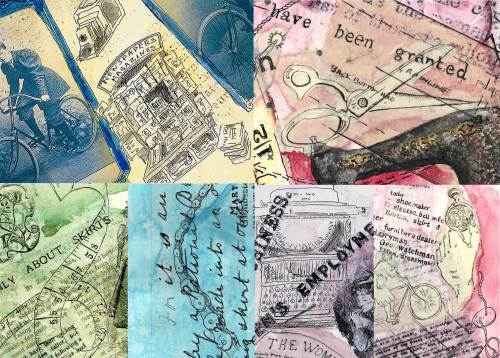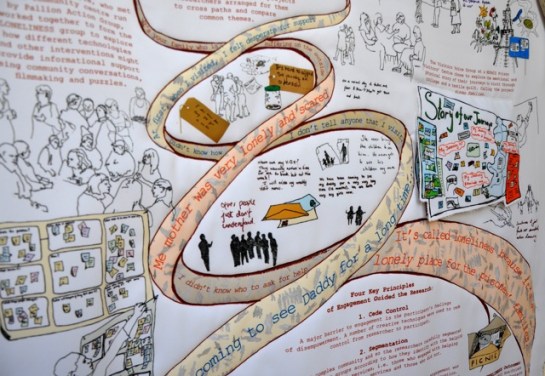Artcodes and smart textiles at the Mixed Reality Lab
March 16, 2016 by aliceangus · Comments Off on Artcodes and smart textiles at the Mixed Reality Lab

Since 2015 I’ve been working with the Mixed Reality Lab and Horizon Digital Economy Research at Nottingham University on their Artcodes/Aesthetocides . I have been part of the Artcodes research team and my work involves helping to research and develop the system through trialing and using it in public situations and testing out artcodes as part of public artworks, in social situatuions, working with groups and members of the public and experimenting with with textiles.
In my textiles reaearch I have been looking at how fabrics and drawings might ‘come alive’ in different ways with the stories that inspired them. My interest is in how the codes can be used materially with fabric, and socially, how they might work in different public situations, in the heritage sector and on costumes in theatre/performance.
The Artcodes app recognises visual codes (artcodes) within sophisticated patterns and illustrations. It allows you to create codes that can be made part of patterns and designs on everyday objects and in artworks. In contrast to image recognition the Artcodes system does not ‘recognise’ a specific image but it scans for a number of solid and blank spaces which can be in any configuration. This means that the shape can change but the code will still be recognised, the code can be shared between different images or patterns, or there can be multiple different drawings that contain the different codes.
I am looking at how codes and be used with different fabrics; as part of artworks, workshops and projects and in garments as part of performances with codes embedded into garments and costumes.
Discovering Bikes and Bloomers
June 4, 2014 by aliceangus · 2 Comments
Over the last few weeks I have been drawing and painting a series works to be printed on silk and wool for a set of unique textile linings for Victorian ladies cycling garments; commissioned for the Freedom of Movement research project created by sociologist Katrina Jungnickel who is based at Goldsmiths, University of London. The drawings are inspired by Kats in-depth research and tell some of the stories behind each patent, the woman who invented it and the social, technological, physical and cultural challenges that early women cyclists had to face .
Through much of my work with Proboscis collaborating with communities, geographers, technologists and social scientists I’ve become interested in how drawing in public or amongst researchers can be a catalyst for conversation, observation and new analysis, revealing hidden connections and sparking alternative ways to interpret ideas and research. So, rather than being isolated from Kats research in my studio I decided to take the work to Kat’s space in the Sociology Department at Goldsmiths, and for the conversation this sparked to inform the content and feel of each drawing as it developed. Kat has a keen interest in making, craft and collaboration so at any time there was drawing, sewing, film-making, photography and desk based academic research all going on in the space. The finished linings are the a record of, and result of those intense drawing activities as well as an interpretation of the research.
One of the features of the cycling garments that attracted me to this project is that they convert from one type of garment to another. A long skirt might be folded, gathered or lifted up to above the knee by some mechanism of cords, buttons or hooks, to reveal bloomers worn underneath or perhaps a long coat on top; in another patent a skirt is taken off, to reveal bloomers, and worn as a cycling cape. In previous projects I’ve explored drawing and textiles, creating images that change or are revealed by the movement of the fabric so it was interesting to now do this with such rich research tied to the form of a historical garment and in conversation with the researcher and her team.
I was surprised to find out how controversial it was for women to cycle (particularly wearing bloomers), they were shouted and jeered at, refused entry to cafes, were socially shunned and had dirt thrown at them. The women who invented these garments had to be highly creative and balance the need for modesty with the need for free movement of the limbs and safety from fabric catching in the mechanism of the bicycle. Despite the privileged backgrounds of the very early cyclists (machines were expensive) I think these women must have had to display great courage and strength of purpose to push against convention, adopting and campaigning for women’s freedom to be accepted as cyclists, to race on cycles and wear clothing that allowed them more freedom.
The garments themselves will be worn and used for storytelling and presenting the research. You can see them in an exhibition at Look Mum No Hands from 7pm on the 13 June 2014 find out more at bikesandbloomers.com
‘Hidden Families’ at Conference on Human Factors in Computing 2013
May 1, 2013 by aliceangus · 5 Comments
As part of our project Hidden Families with Lizzie Coles-Kemp (from the Information Security Group at Royal Holloway University of London). Alice illustrated, digitally printed and created a handmade quilted textile ‘poster’ about the wider project for the 2013 ACM Conference on Human Factors in Computing.
New Threads
January 31, 2013 by aliceangus · Comments Off on New Threads
A delivery of digitally printed fabric arrived this morning with the work for the Hidden Families project and for my mermaids and monsters work. I’ll be spending the next few days sewing up the quilts for Hidden Families partners.
The other fabric that arrived is part of new textile and embroidered work inspired by the traditional knowledge, memories and myths of the sea and water that have come up in Storyweir and Tall Tales Ghosts and Imaginings, In Good Heart and Sutton Grapevine.
Hidden Families
January 16, 2013 by aliceangus · 2 Comments
In the last few months I’ve been working on Hidden Families, a project with families with someone in prison. The project, run by by Lizzie Coles Kemp of the Information Security Group at Royal Holloway University of London, was trying to find out how to improve the way information is made available to families, because people sometimes don’t or can’t engage with support services. The hardships families experience are diverse;- travel, costs of visiting, the huge distances to visit,the stress of uncertain weather and travel conditions that might cause someone to be late and miss their visit, bringing children, access to pension, welfare and benefits advice, sentence planning, prisoner safety and welfare, being stigmatised and outcast, and not expecting help or having the ability to improve the situation.
The project has several facets and I was involved in working with Action for Prisoners Families, NEPACS (who provide support services for families separated by prison), performer Freya Stang and visitors to a visitors’ center in a Category A prison.
Action for Prisoners’ Families (APF),
works for the benefit of prisoners’ and offenders’ families by representing the views of families and those who work with them and by promoting effective work with families…
A prison or community sentence damages family life.
NEPACS builds bridges between prisoners, families and communities that they will return to, they
believe that investment must be made in resettlement and rehabilitation to ensure that there are fewer crime victims in the future, and less prospect of family life being disrupted and possibly destroyed by a prison sentence… After all, the families haven’t committed the crime, but they, especially the children, are greatly affected by the punishment
Lizzie’s approach to working with people differs from typical academic studies. Rather than only surveying or asking questions of a community she collaborates with groups to create projects, workshops and events that are independently of value to that group, rather than just to fulfill research ends, she often works with artists, writers and performers to support partners and participants in articulating ideas.
The project partners and visitors contributed to booklets, postcards, conversations and a wall collage gathering experiences of the practical, technical and emotional issues people face. I brought together the stories, experiences and sketches, with a series of sketches I made, into a digitally printed textile hanging based on the idea of a patchwork quilt for the NEPACS Visitors’ Centre. Participants expressed a wish to produce a version that could hang in the Chapel and Action For Prisoners Families have versions which they will using for their training, education and work raising awareness of the hidden issues families face.
















